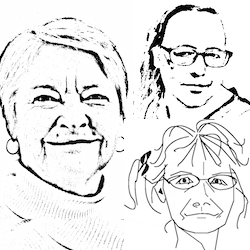
With Debra T. Burhans, Canisius College and Susan Haller, State University of New York at Potsdam
The three of us, from the same Ph.D. cohort at the State University of New York at Buffalo in the 1990’s, applaud efforts to bring more women into computer science. But we are sometimes dismayed by the marketing pitch. Recent efforts emphasize the people-oriented and creative aspects, such as user interface work, to the detriment of the computational aspects [Nilsson].
Our admiration for such people-oriented work is boundless, and we care about saving the world. But that’s not what brought us into computer science. We like the mechanical rigor, the problem-solving, the detail; we like all the dry technical aspects of programming, and the triumph inherent in figuring out how to make it work. In our view, a solid program exhibits a level of accomplishment like no other in human affairs.
No girl should be discouraged by this from taking up any aspect of computer science, and no woman should feel less valued for work in user experience, or web design, or computer graphics, or social media, or technology for a better world. And no boy should be discouraged from, nor man feel less valued for, pursuing those. We don’t claim that some areas of computing work are harder or more worthy or extreme or radical, or that front-end development is fluffy and back-end development is fire. If you’re looking for a status ranking, look elsewhere.
Let’s be clear about the other claims that we are NOT making.
- We don’t claim that computer science is free of sexism. Gender issues remain palpably obvious. The ambitious young men who currently dominate the ranks of tech companies tend to admire other ambitious young men, and collectively practice a high degree of conformity. Their styles of dress, of humor, of comportment, of speech, and of collaboration follow an archetype so strong as to be prohibitive toward confident participation by others.
- We don’t claim that computer science is (or can be or should be) easy for girls, or that our predilections apply to all women, or that recruiting efforts are misguided, or that they inevitably dumb down the curriculum [Klawe]. We support providing support; we are grateful to our advisors. Support matters. In undergraduate classes, in graduate school, on the job early in the career, discouragement awaits and failure lurks. But that was also true for our male counterparts.
Our claim is only that hard-core computing does appeal to women, in contrast to the implication that some areas of computer science are more feminine than others. Certainly we dispute that women are naturally better at some areas than others. That’s not been our experience in work or in teaching classes, although the fact that those classes have been overwhelmingly populated by men means that pesky questions remain.
In fact, we sometimes think that the real problem may not be too few women, but too many men—in the sense that some enter the field because they are persuaded that it’s rife with jobs, or that they can get rich quick, or that they can play with gadgets, or that it’s a cool way to show off [Voyles et al.]. None of these motivations amount to actual interest in hard-core computing. We promote a software engineering sector staffed by those who, like us, take professional pride and find deep fulfillment in the art of problem-solving with computation [Almstrum]. Some have that predilection, and some don’t, all sexes seeming to be represented at every point along the that spectrum; we don’t address the nature versus nurture debate here, or otherwise try to account for the difference in numbers.
In short, bring us sigmoid functions to code, modules to refactor, abstract data types to design, complex business rules to implement, and multithreaded applications to debug. We love that stuff. We understand that some men feel the same way.
References
[Almstrum] Almstrum, Vicki L. 2003. What is the Attraction to Computing? Communications Of The ACM 46:9. DOI:10.1145/903893.903920.
[Klawe] Klawe, Maria. 2015. Closing the computer science gender gap: how one woman is making a difference in many lives. The Conversation, June 8 2015.
[Nilsson] Nilsson, Lina. 2015. How to Attract Female Engineers. The New York Times, April 27 2015.
[Voyles et al.] Voyles, M., Guttschow, G., Fossum, T. and Haller, S. 2001. Gender Differences in Learning Computer Programming. National Association for Research in Science Teaching, St. Louis, MO, March 2001.
Robin K. Hill is adjunct professor in the Department of Philosophy, and in the Wyoming Institute for Humanities Research, of the University of Wyoming. She has been a member of ACM since 1978.




Join the Discussion (0)
Become a Member or Sign In to Post a Comment